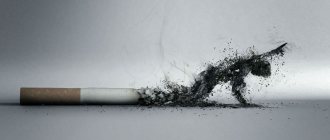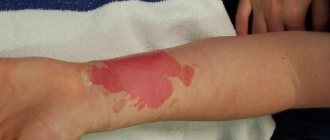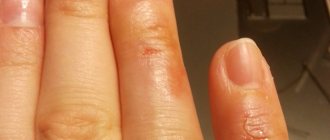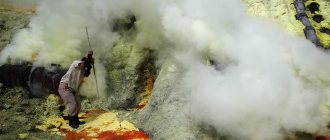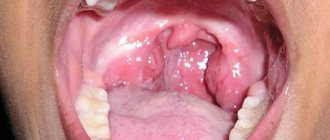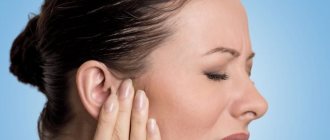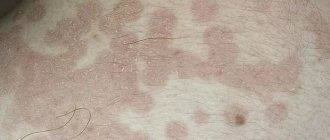Medical Consultant Nephrology Renal colic in men: you cannot delay treatment
Renal colic is accompanied by the appearance of an acute pain attack in the lumbar region. Unpleasant sensations arise due to spasm of the smooth muscles of the urinary system. The pathological process can be provoked by several negative factors at once. In any case, you cannot postpone your visit to the doctor.
- How does renal colic manifest?
- Diagnostics
- Helping a patient with renal colic
Medicines for relieving pain in renal colic - gallery
- Traditional methods of therapy
Lingonberry harvest
- Collection of medicinal herbs
- Raspberry-strawberry collection
- Birch collection
- Traditional recipes for renal colic - gallery
Causes
Let us highlight the main reasons:
- Kidney stones (urolithiasis). The development of pathology in men occurs between 20-45 years. This disease is the formation of stones and sand in the urinary system.
- Oscaluria. Calcium is washed out of the body and mineral metabolism is disrupted. It is forbidden to eat sour foods, sorrel, beans, and chocolate.
- Phosphaturia. This urological disease is a violation of the phosphate balance in the male body. The reason is stress, kidney infections, poor metabolism (metabolism). Symptoms: cloudy white urine, pain in the lower back and when urinating (alkaline reaction), frequent urge to go to the toilet “in a small way”;
- Uraturia is an abnormal increase in salts. The causes of the disease are alcoholism, stress, nervous tension, unhealthy diet, which includes offal, sharp cheeses, smoked meats;
- Cystinuria. A congenital urological disease in which protein metabolism is disrupted and substances such as cystine, ornithine, arginine, and lysine are produced in excess. With this genetic disease, there is a defect in the tubules with the formation of cystine calculi (stones).
- Malignant neoplasms.
- Trauma, congenital pathologies and anomalies.
- Reducing the lumen of the urethra.
- Tuberculosis, renal ischemia, pyelonephritis.
Renal colic is unlikely to go unnoticed, as attacks can be so severe that you have to call an ambulance. Relieve the patient's condition until the emergency.
First aid
The patient needs to create the following conditions before the ambulance arrives:
- Hot bath in a sitting position. But this procedure has a number of contraindications due to the presence of such diseases: cardiovascular, previous heart attack and stroke, old age.
- A warm heating pad on the lower back is an alternative to a hot bath.
- Mustard plasters on the kidney area.
- Antispasmodics – No-shpa, Papaverine, Platiphylline.
Proper first aid before doctors arrive will ease the pain.
Symptoms
Renal colic is accompanied by severe pain in the lower back if stones penetrate through them throughout the system. Signs become obvious, for example, after physical activity, large consumption of water, or the use of diuretics.
Signs of renal colic in men:
- Acute attacks in the lumbar region.
- The patient groans or screams as the stone passes.
- Holds hands on the area where the sign of pain is located.
- Reduced urine flow.
- Weakness of the body.
- Lack of appetite.
- Migraine.
- Frequent urge to go to the toilet.
- Feeling of thirst, dry mouth.
- Pain when a stone passes through the urethra.
- Vomiting and chills.
- Rapid heartbeat (tachycardia).
- Temperature up to 37.1 – 37.5°C.
Since colic is painfully unbearable, as we said above, you cannot do without calling an ambulance. The duration of the attack can reach more than a day if first aid measures are not taken.
Diagnosis, treatment
We have already told you how renal colic manifests itself, and that it is urgent to call an ambulance to localize the problem. After collecting anamnesis, a series of examinations are prescribed, including:
- Blood and urine tests - general, according to Nechiporenko.
- Ultrasound of the kidneys and urinary tract.
- X-ray.
- Chromocystoscopy.
- MRI.
After passing these examinations, the doctor will prescribe conservative therapy, which often occurs on an inpatient basis under the supervision of qualified urologists.
- Elimination of pain with the help of antispasmodics - injections with Baralgin, injections with Platyfillin, No-shpa, Promedol.
- Nonspecific therapy - novocaine blockade of an attack.
- Acupuncture (acupuncture). Treatment is carried out only by doctors who have a license and certain qualified skills, so as not to harm the body.
- Physiotherapy, special physical education.
Therapy consists of relieving symptoms during the passage of the stone. When it comes out naturally, the patient feels much better.
Diet
If you have renal colic, you should not consume the following foods:
- Salty.
- Broths and hot sauces.
- Beans and sorrel leaves.
- Spinach.
- Seasonings.
- Fruits and vegetables are sour.
- Sweets, chocolate, coffee.
During the diet, it is recommended to eat protein foods:
- Quail egg – 2 pcs. in a day.
- Lean poultry and fish.
- Cereal porridges without added lactose (milk).
- Sour apples.
- Pumpkin, juice from it.
- Pasta, wholemeal bread.
Timely treatment and elimination of renal colic will prevent complications. Subscribe to our website. Don't miss out on a lot of useful information.
Renal colic in men
― pathology of the urinary system, the main symptom of which is sharp cramping pain in the lumbar region. These sensations arise due to a violation of the outflow of urine due to blockage or narrowing of the ureter. At the same time, there is an increase in pressure inside the organ and a decrease in blood circulation in the kidneys, leading to spasm of smooth muscles.
In 90% of cases, the occurrence of pathology is associated with the formation of stones in the kidneys or upper urinary tract. Nephrolithiasis and diseases of the genitourinary system can develop for several reasons: metabolic disorders, lack of vitamins C, D and P or chemical elements (silicon, molybdenum), age-related changes in the body.
This pathology occurs in 20% of men and 7% of women. Usually the right, less often the left, kidney is affected; in 20% of cases, renal colic is found in both kidneys at the same time.
How to understand that a person has renal colic
If renal colic does not occur for the first time, the patient recognizes a relapse by the characteristic sensations. In addition, the pathology develops against the background of various kidney diseases:
- urolithiasis (ICD);
- pyelonephritis - bacterial inflammation of the kidneys;
- glomerulonephritis - autoimmune inflammation of the renal glomeruli;
- tumors blocking the flow of urine, etc.
Table: diseases causing ureteral obstruction
| Cause of ureteral obstruction | Occlusion (blockage) | Narrowing or bending | Edema | ||
| Stone | Blood clot | Purulent and fibrin formations | |||
| Disease provocateurs | UCD, accompanied by the movement of solid formations along the urinary tract |
|
|
| General allergic reactions to medications (antibiotics, iodine preparations, etc.) |
You can suspect renal colic due to the following symptoms:
- Sharp, sudden pain. Occurs because urine does not leave the kidney when the ureter is blocked. The organ increases in size, causing irritation of the nerve endings. Often pain is projected in the lumbar region from the side of the pathological process, but can radiate to the outer surface of the thigh, groin, head of the penis in men and the vaginal area in women.
With renal colic, the pain often radiates below the site of blockage of the ureter with a stone - Restlessness, fussiness. The patient constantly changes body position and does not sit still.
Most often, with renal colic, the patient takes a forced body position standing or sitting, holding his lower back with his hands and leaning slightly forward - Painful, frequent urination or a decrease in the amount of urine produced are possible but not necessary symptoms. If one kidney is working properly, a decrease in urine output is difficult to notice. Painful urination occurs when a stone from the ureter enters the bladder. Urination becomes more frequent when the ureter at the outlet to the bladder is blocked.
- An increase in body temperature to 37.5–37.8 °C, less often - higher, which is accompanied by chills and trembling.
- Digestive tract disorders (nausea, vomiting, gas retention in the intestines).
- Increased blood pressure (BP).
Causes
The causes of renal colic in men are associated with the age and place of residence of the patient. The average age of people with this disease is 30-50 years. A hot climate, high humidity and poor environmental conditions contribute to the occurrence of renal colic.
Impaired outflow of urine can be caused by the presence of stones in the urinary organs, clots of pus or blood, swelling of the mucous membranes, tumor formations, kinking or compression of the ureter.
In medicine, the following 8 private risk factors for the development of renal colic are identified:
- Heredity - in 50% of cases there is a disease transmitted from generation to generation.
- Professional activity: working with heavy weights, in a hot shop.
- Excessively intense physical activity.
- Congenital anatomical disorders of the urinary system.
- Malabsorption is a violation of the absorption of nutrients in the small intestine.
- Improper diet - excess salt and protein foods.
- Dehydration or losing too much fluid.
- Trauma to an organ due to blows or an accident, causing compression of the urinary tract.
Why is it possible for the stronger sex to develop renal colic?
Such pain syndrome quite often accompanies various pathologies of the urinary system. Renal colic develops when the usual movement of processed fluid from any part of the urogenital tract is disrupted. In this condition, the blood supply stops, the pressure inside the pelvis increases, and inflammatory swelling of the organ occurs. The obstacle can be located both outside and inside.
The main causes and factors provoking the development of renal colic:
- inflammation of the cups and pelvis;
- glomerulonephritis;
- urolithiasis disease;
- malignant and benign formations;
- urethritis;
- bladder damage;
- prostatitis;
- pyelitis;
- kidney cyst;
- poisoning by toxic gases and liquids;
- overdose of certain medications;
- nephroptosis - organ prolapse;
- cicatricial and ulcerative narrowing of the ureter and urethra;
- abnormalities in the development of the excretory system (deformed bladder or its partial absence);
- recently suffered infectious diseases (hepatitis, HIV, tuberculosis, syphilis);
- prostate tumors.
Symptoms of renal colic
Stinging pain in the lower back occurs unexpectedly and is not associated with physical activity or nervous tension. It cannot be eliminated by changing the position of the body, so patients exhibit restless behavior, they rush around, moan, and keep their hands on their lower back. Pain can occur in different places on the body and radiate to the leg, pubic area, head of the penis, and scrotum. Doctors associate this phenomenon with the localization of blockage in the urinary tract.
With stone formation in the kidneys and ureters, painful sensations form in the upper part of the lower back, and there is a strong urge to have a bowel movement. When stones are located in the urinary tract, pain is felt in the lower abdomen.
Associated symptoms are nausea, single vomiting, headaches, hyperthermia, and bloating. The process of urination is disrupted, there is a frequent urge to urinate, and blood can be found in the urine.
In severe attacks, a painful shock occurs, after which the patient experiences a weak pulse, high blood pressure, profuse sweating, and pallor. Typically, an attack of colic lasts about a day.
Differentiation from similar diseases
Diagnosing renal colic is quite difficult because it is associated with a group of diseases with similar symptoms. Acute diseases of the abdominal organs are also characterized by nausea, fever, and stabbing pain in the lower back. These include acute appendicitis, biliary colic, gastric ulcer, and volvulus.
It is important to distinguish renal colic from the acute form of appendicitis. In the first case, the pain cannot be reduced and pulsation occurs in the thigh, pubic area, and head of the penis. With appendicitis, the pain is localized in the right iliac region and is relieved by lying on the back or right side.
Hepatic colic is very similar in symptoms to renal colic. The patient also experiences persistent pain, nausea, and fever. But in patients with biliary colic, the nature of the disease is different - symptoms occur after eating too fatty foods, and the pain pulsates in the area of the scapula and collarbone.
The difference between renal colic and acute intestinal obstruction can be done by urinalysis and listening to the abdomen to help detect bowel sounds. The initial symptoms of both diseases are very similar - constant, incessant pain, nausea and vomiting.
Features of attacks in children and pregnant women
Renal colic is less common in children than in adults. But it is difficult to identify this condition in a child without examination. Preschool children cannot describe sensations reliably. They fuss and cry. It is sometimes impossible to understand that severe pain lies behind hysteria.
In both children and adolescents, pain is localized mainly in the navel area, so it is difficult to distinguish renal colic from other pathologies of the gastrointestinal tract. The anterior abdominal wall will certainly be tense. In children, attacks last 15–20 minutes, but recur after a while.
If you ask a child during an attack of renal colic where he hurts, he will point to the navel area or say that it hurts everywhere
It is prohibited to independently help a child with renal colic, especially if it occurs for the first time. The parents’ task is to call an ambulance as quickly as possible, and until they arrive, try to distract and calm the baby.
Renal colic is no less dangerous for pregnant women. If it occurs in the first or second trimesters, there is a risk of spontaneous miscarriage. After 30–31 weeks, an attack can trigger premature labor.
If at the time of pregnancy a woman had kidney stones or chronic pyelonephritis, she needs to prevent renal colic with diet and medications prescribed only by a doctor. The development of an attack at any time requires immediate hospitalization.
Diagnosis of renal colic
If signs of renal colic are detected, you should immediately call a doctor at home. After the symptoms subside, you need to contact a nephrologist. The doctor will take a detailed medical history and send you for laboratory and hardware examinations.
During the initial examination, the doctor pays attention to the general condition of the patient, most often there is anxiety on his face, it is difficult for the person to sit in one place, he rushes about. The positivity of Pasternatsky's symptom is checked when pain occurs when tapping the edge of the palm on the lower back, which indicates kidney damage.
The patient will need to undergo a general urine test, in which a large number of red blood cells and impurities (blood, pus, salts, stone fragments) can be detected. Among hardware diagnostic methods, ultrasound, x-ray, and excretory urography are used.
An ultrasound examination is performed on an empty stomach and a full bladder. The patient lies down on a couch and a special conductive gel is applied to his stomach, allowing the image to be transmitted to a computer monitor. This examination can detect urolithiasis, pyelonephritis, kidney cysts and tumors.
Using x-rays, the doctor evaluates the structure and structure of the kidneys, pathological formations in the organ, prolapses and displacements. An overview image of the abdomen is taken with the intestines cleansed, so an enema should be done the evening before the procedure.
Excretory urography is performed by injecting a contrast agent into a vein, which makes it possible to assess the condition of the kidneys and ureters, the presence and location of stones. The administered substance is excreted independently in the urine.
The most informative diagnostic method is computed tomography and magnetic resonance imaging. This examination allows you to examine the organ layer by layer in two-dimensional space. The disadvantage of tomography is its high cost.
Treatment options
Most often, men who have previously been diagnosed with a disease of the urinary system - nephrolithiasis - go to the doctor with renal colic. In this case, you should take a hot bath or put a heating pad on your lower back, take a painkiller tablet (Baralgin, Noshpa, Analgin, Spazgan, Nitroglycerin). An antispasmodic will help relieve pain and spasms, relax the smooth muscles of the excretory organs.
If these symptoms are observed for the first time, then you should not take any action until the doctor arrives. After confirming the diagnosis, drug treatment is prescribed to relieve pain. The main drugs for the disease are: Ketorolac, Drotaverine, Baralgin M.
In cases where renal colic occurs in men with previously identified diseases of the urinary system, the patient has the opportunity to be treated on an outpatient basis, that is, at home. The patient is prescribed plenty of fluids, bed rest and heating pads. If your condition worsens, you should consult your doctor again.
Prevention and diet
To avoid this painful symptom, preventive measures should be taken.
A diet for renal colic in men includes the consumption of lean meats and fish, eggs, pumpkin, apples, honey, premium pasta, watermelon and melon, decoctions of medicinal herbs (rose hips, cranberries, raspberries, chamomile, lingonberries), and jelly. It is necessary to exclude from the diet foods containing excess salt (salted fish, liver, kidneys, broths, smoked meats, canned food).
The patient should reduce the amount of alcohol, garlic, mushrooms, mustard, cocoa, coffee, chocolate, tomatoes, carrots, spinach, beets, jam, confectionery and flour products. Monitor fluid intake (at least 2 liters per day), avoid stressful situations and hypothermia. To live an active lifestyle.
Consult a doctor in a timely manner for infectious and viral diseases, visit a urologist every six months and undergo general urine and blood tests. Observe daily hygiene measures for the care of the external genitalia, avoid unprotected and promiscuous sexual intercourse.
Renal colic in men is a sharp spasm of the kidney muscles, which causes an attack of acute pain in the lumbar region, radiating to the groin, abdominal cavity, buttocks and leg. The cause of colic may be urolithiasis with the advancement of stones, inflammatory pathologies (pyelonephritis, glomerulonephritis), renal failure, nephroptosis or hydronephrotic transformation.
Manifestation
Renal colic is not a disease, but a symptom that indicates other diseases. It is characterized by the appearance of sharp, acute and unbearable pain in the lumbar region. When the pathological process is localized in the left kidney, the pain syndrome covers the left side and side. When the right organ is affected, a feeling of pain and discomfort spreads along the right side of the lumbar region.
Pain in the right side is often a sign of liver pathologies or inflammation of the blind appendix of the intestine.
A feature of colic is the irradiation of an unpleasant symptom. In men, the feeling of pain can spread to the groin area and cover the external genitalia. If the pain syndrome spreads throughout the abdominal cavity and extends to the navel, the cause may be a blockage of the ureter at the site of its exit from the renal pelvis.
The severity of the symptom in men increases during emptying of the bladder - a feeling of discomfort and burning in the urethra occurs. Blood may be excreted in the urine. This sign indicates the movement of stones through the urinary organs, resulting in injury to their walls. There is also a decrease in the amount of urine discharge, while the urge to urinate may increase. The patient may have a feeling of incomplete emptying of the bladder. During general clinical studies, an increase in the level of protein and mucus in urine is determined.
Interesting! During physical activity, prolonged walking, and significant fluid intake, the pain syndrome may intensify.
Other symptoms of renal colic in men may also be present. There are frequent disorders of the digestive tract, which manifest themselves in the form of nausea, flatulence, severe vomiting and diarrhea. Symptoms of intoxication lead to loss of appetite and a feeling of weakness.
Headaches are common. With severe intoxication, body temperature rises, which indicates the presence of an inflammatory process in the kidneys. If the outflow of urine is disrupted, an increase in intrarenal pressure is observed, against the background of which blood pressure levels rise. Impaired diuresis causes swelling of the limbs, and later the face and body swell.
Typical symptoms in adults and nature of pain
An attack of renal colic most often begins during significant physical activity or human movement. Often the impetus for the passage of a stone is given by driving on an uneven road or shaking. But an attack can occur without a provoking factor - at rest or even in sleep.
Passage of stones
The duration of the attack, depending on the speed of movement and the size of the foreign body, varies from 20 minutes to several days. If the stone is small and smooth, then the pain attack ends within 2–3 hours. What causes the patient most concern is small, sharp-angled stones: they are very mobile, take a long time to move and easily injure the mucous membranes of the urinary tract.
Often several small stones come out with urine during an attack of colic. After the first one moves away, temporary relief occurs, but with the start of the next one, the pain resumes.
In some patients, stones pass painlessly.
Hematuria
With renal colic, there is an admixture of blood in the urine, sometimes quite intense; Blood clots are often visible to the naked eye. When examining urine sediment in a laboratory, even if it is visually of normal color, an increased number of erythrocytes (red blood cells) is detected.
Blood in the urine with renal colic can be visible to the naked eye, but may not be externally present
For renal colic caused by urolithiasis, it is typical that pain precedes the appearance of bleeding and marks the beginning of stone migration. With other urological pathologies, the opposite happens. First, a person develops hematuria, and later it is accompanied by an attack of colic, provoked by blockage of the ureter with a large blood or purulent clot.
Gastrointestinal, general and dysuric disorders
Due to the fact that during colic there is irritation of not only the renal, but also the celiac nerve plexus, typical symptoms of this condition are nausea and vomiting. Abdominal bloating occurs due to delayed passage of gases and stool.
Nausea and vomiting during renal colic are caused by irritation of the celiac nerve plexus
The patient becomes pale and covered in cold sweat. His temperature rises, often accompanied by headache, weakness, and dryness of the oral mucosa.
If a foreign body stops in the final (vesicular) segment of the ureter, a person experiences frequent, painful and unproductive urge to urinate. During an attack of renal colic, sometimes there is even acute retention of urine caused by blockage of solid foreign bodies in the urinary tract.
A stone lodged in the area of the bladder neck can cause acute urinary retention.
Nature of pain
A large calculus, tightly embedded in the kidney, as a rule, does not interfere with the outflow of urine and does not cause renal colic. For an attack to occur, an incomplete blockage of the ureter by a small stone or an accumulation of urinary salt crystals is sufficient.
A painful attack due to renal colic overtakes a person suddenly. Unbearable pain forces him to rush around and change his position every minute in the hope of finding a position in which it will become less. Most often, the patient lies on his side with his knees pulled up to his stomach. This restless behavior of the patient is explained by the fact that each new change of position brings some relief for a short time.
Sometimes a person during renal colic takes the most sophisticated, bizarre body positions. People refer to this type of behavior as “climbing the wall.”
By the nature of the spread of pain, you can approximately determine on which part of the urinary tract the stone is currently located. The lower the foreign body moves along the ureter, the more intense the pain radiates to the leg on the affected side and to the genitals.
While the obstruction is in the pelvis or in the upper segment of the ureter, the pain is localized in the lumbar region. But as soon as the stone descends into the lower segment of the urinary tract, it moves to the iliac or inguinal zone of the body.
Video: symptoms of renal colic
First aid
If a spasm occurs in the lumbar region, you must call an ambulance. Pain in the lumbar region can indicate many diseases, so it is important to undergo studies that allow you to determine the cause of the discomfort and prescribe appropriate treatment. Delay may lead to complications.
Medical assistance is needed when:
- hyperthermia reaches critical levels of 38-39 0 C;
- the number of urges to empty the bladder increases, discomfort and burning occur;
- a white precipitate or flakes, impurities and blood clots are found in the blood;
- symptoms of intoxication develop;
- the body swells.
So, what to do before medical personnel arrive, and how to provide first aid? A man needs to be given rest. Active movements and physical activity only increase the pain syndrome and lead to the development of complications.
If the patient is sure that the cause of renal colic is a disease of the urinary system, you can take painkillers or antispasmodics that will help temporarily relieve pain and wait for an ambulance or go to a medical facility on your own. For this purpose, antispasmodics are suitable, which are in every first aid kit - No-shpa, Spazgan, Papaverine. Among the analgesics, Analgin will help cope with the unpleasant symptom. Non-steroidal anti-inflammatory drugs – Ibuprofen and its derivatives – are no less effective.
Heat also helps to cope with renal colic, however, this method can be used if the patient is sure that the syndrome is not the result of inflammatory pathologies. A man can take a warm bath, but it is important that the water covers the lumbar region of the back. The duration of the procedure is no more than 15 minutes. You can add a decoction of medicinal herbs to the water, which will help enhance the effectiveness and also have an anti-inflammatory, regenerating effect. Chamomile, calendula, and elecampane are suitable for this purpose.
Interesting! An attack of renal colic can last from several minutes to several hours. The maximum duration of the symptom is up to 18 hours.
You can replace the bath with local applications, which are performed using a heating pad or a bottle of warm water. Compresses are made using medicinal decoctions (chamomile, sage, horsetail, conifers, eucalyptus) - prepare a decoction and moisten a cloth, apply to the sore spot.
Treatment
Renal colic in men leads to a deterioration in the general condition and leads to bedridden conditions. Therefore, if pain and signs of intoxication appear, you should consult a doctor. After the condition improves, it is necessary to go to a medical institution to see a generalist - a general practitioner, who, after an initial history and examination, refers the patient to a urologist and nephrologist. Specialist doctors prescribe diagnostic procedures that help determine the cause of renal colic. If a disease of the digestive system is suspected, the therapist refers the man to a gastroenterologist.
Diagnostics
When making a diagnosis, differential diagnosis plays an important role, since renal colic, as a symptom, can indicate many pathologies:
- Acute appendicitis occurs with a similar symptomatic picture. The pain covers the right side of the lumbar region, side and abdominal cavity. Inflammation of the appendix and renal pathologies can be distinguished by the nature of vomiting, in the latter case it occurs immediately, and by the position of the patient - with appendicitis the patient lies motionless, when with colic “there is no place.”
- Hepatic colic has similar symptoms, but it can be differentiated by the distribution of the pain syndrome. In the first case, the pain covers the chest, right shoulder blade and shoulder, in the second it radiates to the bottom - the groin, thigh, leg.
- Intestinal obstruction is characterized by pain in the intestinal area and has a cramping nature, occurring with hyperthermia above 38 0 C. With renal colic, the pain syndrome is constant, and the body temperature does not exceed subfebrile levels.
- Radiculitis has a more pronounced pain syndrome and does not lead to an increase in thermometer readings, unlike renal colic.
- Inflammation of the genital organs and renal colic can be differentiated by the location of the pain. The first pathology leads to pain in the lower abdomen, which radiates to the sacral region, while the second causes discomfort in the lumbar region.
To make a diagnosis, laboratory tests of urine and blood are prescribed. Gemma allows you to determine the presence of an inflammatory process in the body, the performance of paired organs, acid-base balance, as well as the level of electrolytes, calcium and sodium.
An increase in the number of leukocytes in urine indicates an infection of the kidneys, hematuria - blood in urine - indicates urolithiasis. Protein and mucus also indicate the presence of pathological processes. A change in acidity indicates the presence of bacterial flora or calculi. To identify the causative agent of the infectious-inflammatory process, a bacteriological urine test is prescribed.
To study the condition and performance of paired organs, instrumental research methods are used - ultrasound, X-ray, excretory urography, CT and MRI.
Drug treatment
Based on the data obtained, symptomatic treatment of renal colic in men is carried out.
To relieve pain, oral or intravenous administration of antispasmodic and analgesic drugs is prescribed: No-shpa, Papaverine, Analgin, Ibuprofen. In case of intolerable syndrome and lack of effectiveness of these medications, novocaine blockade is performed by injecting the drug into the perinephric tissue.
To reduce body temperature, antipyretic drugs are used - Paracetamol, Panadol, Efferalgan. Anti-inflammatory non-steroidal drugs are also prescribed, which will help not only cope with hyperthermia, but also stop the inflammatory process. Such drugs include Ibuprofen and its derivatives, Ketorolac, Analgin, Acetylsalicylic acid.
Next, treatment is carried out for the underlying cause of the disease, which led to the development of renal colic. To treat nephritis, antibacterial drugs of the penicillin series (Amoxicillin), cephalosporins (Cefuroxime, Ceftriaxone) and macrolides (Erythromycin) are prescribed. In the case of a viral etiology of inflammatory pathologies, antiviral drugs are used, in case of a fungal nature - antifungal agents (Biseptol, Etazol).
For urolithiasis, medications are prescribed that will help dissolve and remove stones from the organs of the urinary system: Cyston, Avisan, Olimentin.
Other therapies
If the symptoms are clearly expressed and do not improve after drug therapy, the doctor recommends surgery. In case of urolithiasis, surgical intervention is aimed at crushing and removing stones. For this purpose the following is used:
- Remote lithotripsy involves the destruction of stones at a distance using ultrasound or laser waves. May cause damage to healthy tissue.
- Contact lithotripsy involves the destruction of stones with air, laser and ultrasound. They are performed through a puncture in the skin (percutaneous nephrolithotomy) and the urethra (urethroscopy). The methods help prevent damage to neighboring organs.
- Endoscopic surgery involves 3 incisions in the tissue in the kidney area, through which the solid tumor is removed.
- Open abdominal surgeries are used when there are contraindications to minimally invasive methods and to provide emergency care.
If renal colic is a sign of nephrolithiasis, then ureteral catheterization is used to relieve pain. Helps relieve symptoms and remove stones without damaging the ureteral tissue. In addition, installing a drainage system allows you to restore the normal outflow of urine and remove crushed stones.
An important place in treatment is occupied by diet, which is based on treatment table No. 7 and its modifications. Allows you to reduce the load on paired organs and prevent complications. During treatment, the patient must give up “harmful foods”: fried, fatty, smoked, carbonated, sweet drinks, canned food. The basis of the diet should be vegetables, fruits and cereals. For the treatment of urolithiasis, the diet is prescribed based on the chemical structure of the stones.
Renal colic is not an isolated disease. This is a symptom that indicates the presence of pathological processes in the kidneys. Most often it is a sign of urolithiasis. Occurs with severe symptoms of intoxication and hyperthermia. To relieve pain, antispasmodics and painkillers are used, as well as treatment aimed at eliminating the underlying cause of the disease.
Diagnostics
Classic renal colic has a typical clinical picture, and its recognition is not particularly difficult for an experienced urologist. There are several methods that allow you to cast aside all doubts about the diagnosis.
Palpation and percussion
Healthy kidneys usually do not react in any way to palpation. With typical colic, two-handed palpation of the lumbar region intensifies the attack. When pressing on the abdominal wall in the direction of the affected ureter, sharp pain is noted. When a person quickly turns over to the other side, an increase in painful sensations is also observed.
With colic, palpation of the kidney area intensifies the attack
The classic manifestation of renal colic is Pasternatsky’s symptom, which is detected in this way: the examiner places one hand on the patient’s kidney area, palm down, and taps it lightly but confidently with the edge of the other. If the pain intensifies, then Pasternatsky’s symptom is considered positive. If the patient does not notice any discomfort, the sign is negative. Often, after determining a positive Pasternatsky symptom, a patient with renal colic appears to have blood in the urine.
Laboratory research
Deviations from the norm in the results of laboratory tests of biological fluids of the body cannot be considered as a reliable sign of renal colic. The only characteristic of it is an increased number of erythrocytes (red blood cells) in the urine - hematuria.
Typical laboratory symptoms of the inflammatory process (increased ESR, shift of the leukocyte formula to the left, leukocytosis in the blood) are indirect and can occur both in renal colic and in other acute diseases of the abdominal organs.
Changes in urine characteristic of urolithiasis may not be observed during an attack of renal colic due to complete blockage of the affected ureter by a foreign body.
Instrumental methods
Urgently performed x-ray examinations play a decisive role in recognizing renal colic.
Survey radiography
First of all, the patient undergoes a simple plain radiography of the abdominal organs. Already at this stage, the shadow of a foreign body is often detected in the urinary tract, which allows a diagnosis to be made with almost 100% accuracy. However, you should consider the possibility of stones and blood clots in the veins or any inclusions in the intestines visible on the x-ray.
The image clearly shows a large stone located in the renal pelvis
The presence of colic is indicated by an important radiographic sign - an area of rarefaction surrounding the shadow of an enlarged kidney. It is the result of swelling of the perinephric tissue.
Excretory urography
The second stage of instrumental diagnosis is excretory urography. In this case, the patient is given an intravenous radiopaque solution, which is excreted by the kidneys with urine and makes the urinary tract visible on urograms. The method also makes it possible to distinguish the outlines of a stone in photographs.
The image shows that the path of urine in the ureter on the right is blocked
Based on the results of excretory urography, the degree of renal dysfunction is assessed. At the height of an attack of colic on the affected side, the organ may not work at all. However, the shadow of the diseased kidney increases due to the fact that its parenchyma is saturated with a contrast solution. This phenomenon indicates that the function of this organ is preserved and can be restored.
The urographic method reveals the secretion of a contrast agent by both kidneys. During an attack of colic, dilation of the pelvis and upper part of the ureter is observed on the affected side. The lumen of the latter is filled with a contrast solution to the level of overlap with the stone.
Differential diagnosis
There are many conditions that mimic renal colic. Therefore, it is necessary to know their main distinguishing features. For example, perforated gastric ulcer, appendicitis, acute diseases of the gallbladder and liver must be distinguished from right-sided renal colic, pancreatitis - from left-sided, and inflammation of the female reproductive system - from bilateral.
Unlike renal colic, other diseases with the clinical picture of an “acute abdomen” are distinguished by the patient’s desire for peace, because the slightest movement increases the pain. As they say, a person “lies flat” in this case. And no matter how severe the pain with renal colic, the patient’s general condition suffers little. During it, there are no manifestations of general intoxication typical of diffuse peritonitis.
Table: differential signs of renal colic and similar diseases
| Disease | Localization and irradiation of pain | Patient behavior | Nature of pain | Associated phenomena | Urinary disorders |
| Renal colic | In the lumbar region; gives off to the inner and anterior thigh and external genitalia | Restless | Acute, sudden, often with exacerbations and remissions | Nausea, vomiting, intestinal paresis; with a low location of the stone - the urge to urinate | If the stone is located in the vesical segment of the ureter or in the bladder |
| Acute appendicitis | In the right groin area or in the navel area; gives off to the upper part of the abdominal cavity | motionless | Sudden, gradually increasing | Symptoms of peritoneal irritation | Only for pelvic localization of the appendix |
| Acute inflammation of the uterine appendages | In the lower part of the abdominal cavity; radiates to the lower back, groin, external genitalia | Normal | Gradually increasing | Symptoms of irritation of the peritoneum and pelvic floor | Sometimes |
| Acute lumbar radiculitis | In the lower back, along the nerves; radiates to the back of the thigh | motionless | Sudden, acute or gradually increasing | Characteristic of neurological diseases | No |
| Hepatic colic | In the right hypochondrium; radiates to the scapula, shoulder, back | Restless | Sudden, acute | Tension of the anterior abdominal wall, often jaundice, diarrhea | No |
| Acute pancreatitis | In the area of the left kidney | motionless; often shock of varying severity | Sudden, sharp, piercing | Signs of general intoxication and peritonitis | No |
| Intestinal obstruction | Most often - throughout the entire abdominal cavity, without clearly defined localization | Restless; often shock of varying degrees | Sudden, cramping | Depends on the level of obstruction | No |




